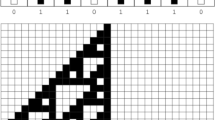Abstract
The model of self-organized criticality (SOC) is a useful tool to understand the complexity of natural systems in the form of the artificial life and the artificial market. However, SOC remains the question what guarantees the criticality even though the natural systems seem to keep itself in the critical state. In this paper, we focus on the locality of interaction in zero-intelligence plus (ZIP) model. The extremely localized interaction changes the behavior of the ZIP model from equilibrium to intermittency. Although the original ZIP model falls into unstable with some noise, extremely localized interaction model archives robust intermittency against the noise parameter. Further, the statistical property of intermittent behavior shows the power-law nature.





Similar content being viewed by others
Explore related subjects
Discover the latest articles, news and stories from top researchers in related subjects.References
Ladley D (2012) Zero intelligence in economics and finance. Knowl Eng Rev 27(2):273–286
Farmer JD, Patelli P, Zovlko II (2005) The predictive power of zero intelligence in financial markets. PNAS 102(6):2254–2259
Biondo AE, Pluchino A, Rapisarda A (2015) Modeling financial markets by self-organized criticality. Phys Rev E 92(4):042814
Yim K, Oh G, Kim S (2016) UNdestanding financial market states using an artificial double auction market. PLoS One 11(3):e0152608
Gunji YP (2014) Self-organized criticality in asynchronously tuned elementary cellular automata. Complex Syst 23(1):55–69
Murakami H, Tomaru T, Nishiyama Y, Moriyama T, Niizato T et al (2014) Emergent runaway into an avoidance area in a swarm of soldier crabs. PLoS One 9(5):e97870
Reynolds CW (1987) Flocks, herds and schools: a distributed behavioral model. Comput Gr 21(4):25–34
Czirók A, Vicsek T (2006) Collective behavior of interacting self-propelled particles. Phys A 281:17–29
Viswanathan GM, Buldyrev SV, Havlin S, da Luz MGE, Raposo EP, Stanley HE (1999) Optimizing the success of random searches. Nature 401:911–914
Murakami H, Niizato T, Tomaru T, Nishiyama Y, Gunji YP (2015) Inherent noise appears as a Lévy walk in fish schools. Sci Rep 5(10605):1–11
Gode DK, Sunder S (1993) Allocative efficiency of markets with zero-intelligence traders: market as a partial substitute for individual rationality. J Polit Econ 101(1):119–137
Cliff D, Bruten J (1997) Less than human: simple adaptive trading agents for CDA markets, Tech. Rep. HP–97–155, Hewlett-Packard Company
Bagnall A, Toft I (2006) Autonomous adaptive agents for single seller sealed bid auctions. Auton Agents Multi-Agent Syst 12(3):259–292
Jen E (2003) Stable or robust? What’s the difference? Complexity 8(3):12–18
Sasai K, Gunji YP (2008) Heterarchy in biological systems: a logic-based dynamical model of abstract biological network derived from time-state-scale re-entrant form. Biosystems 92:182–188
Plerou V, Gopikrishnan P, Amaral LAN, Gabaix X, Stanley HE (2000) Economic fluctuations and anomalous diffusion. Phys Rev E 62:R3023–R3026
Tseng JJ, Lin CH, Lin CT, Wang SC, Li SP (2010) Statistical properties of agent-based models in markets with continuous double auction mechanism. Phys A 389:1699–1707
Author information
Authors and Affiliations
Corresponding author
About this article
Cite this article
Sasai, K., Gunji, YP. & Kinoshita, T. Extremely localized interaction in a market model. Artif Life Robotics 22, 125–129 (2017). https://doi.org/10.1007/s10015-016-0334-1
Received:
Accepted:
Published:
Issue Date:
DOI: https://doi.org/10.1007/s10015-016-0334-1




